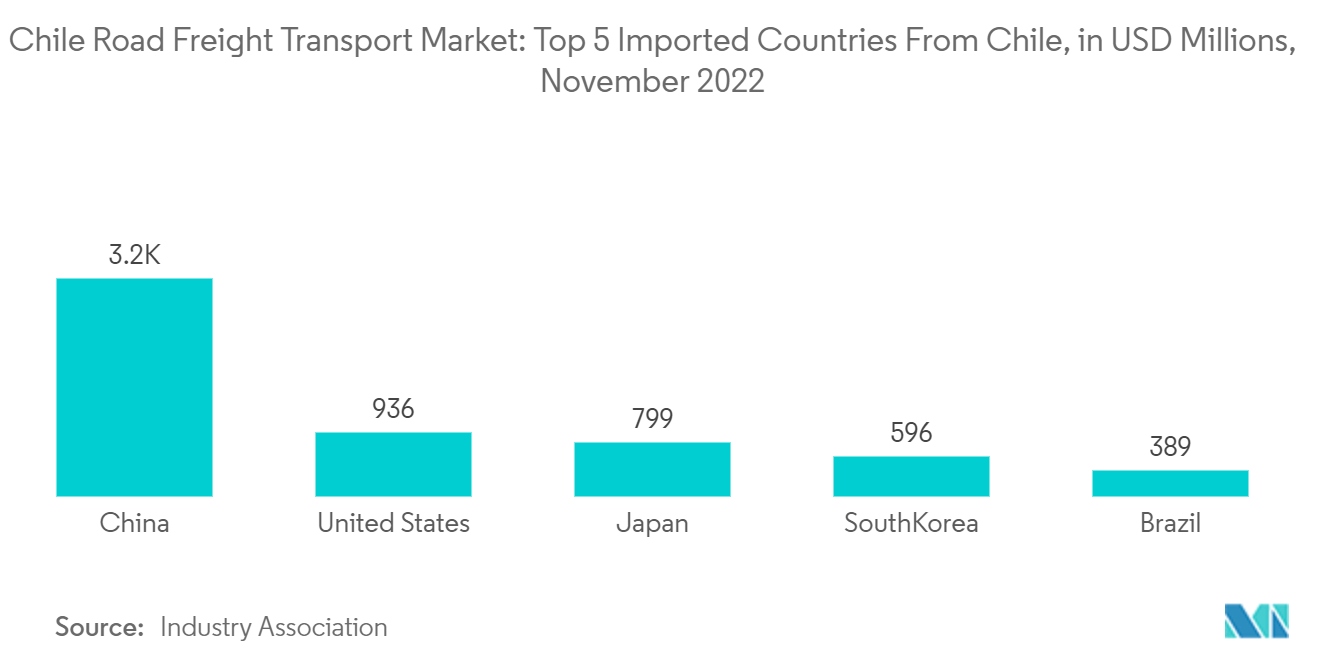Market Trends of Chile Road Freight Transport Industry
Growth in the E-commerce Sector is Driving the Market
eCommerce has grown over the last ten years, thanks to Chile's fast and ongoing development of its technological infrastructure, the launch of 5G service in December 2021, and the growing popularity of eCommerce since the start of the pandemic.In 2021, B2C eCommerce sales reached USD 11.6 billion, a 23 percent increase compared to 2020, and in 2022 eCommerce sales are up by the same rate, reaching USD 14.3 billion. In addition to the influence of the COVID-19 pandemic on eCommerce growth, other contributing factors are pension fund withdrawals and the government's financial stimulus.
According to industry sources, e-commerce is forecast to grow by 28 percent for the period 2020-2024, reaching USD 35 billion in sales. The number of eCommerce users is expected to grow by 11 percent to 13 million by 2025. The factors driving this growth are an 86 percent internet penetration rate in 2021 and incentives provided by discounts and massive events such as Cyberdays. The demographics of online shoppers are evenly divided between men and women.
The largest demographic using eCommerce is 25 to 34 year olds (28 percent), followed by 35 to 44 year olds (24 percent), 45 to 54 year olds (19 percent), 18 to 24 year olds (17 percent), and 55 to 64 year olds (13 percent). Most buyers have a high household income (37 percent), followed by low income (33 percent) and middle income (30 percent). The top five eCommerce product categories are clothing (75 percent), shoes (73 percent), consumer electronics (65 percent), food and drinks (58 percent), and household appliances (55 percent).
In the second quarter of 2022, 18% of cross-border e-commerce purchases from Amazon were made in Chile. Meanwhile, AliExpress's market share decreased from 42 percent in the third quarter of 2019 to 19 percent in the same quarter of 2022. Another popular e-commerce platform in Chile is Mercado Libre, headquartered in Buenos Aires, Argentina.

Rise in Trade in the Country is Witnessing a Significant Growth in the Sector
As globalization has grown over the past few years, more trade-related activities have sprung up.Globalization is getting stronger, which has led to more manufacturing and trading in the country.As trade grows, it becomes more important to find efficient ways to move goods, which helps the road freight transportation market in Chile grow.
Chile exported USD 7.97 billion and imported USD 6.27 billion in November 2022, resulting in a USD 1.7 billion positive trade balance. Between November 2021 and November 2022, the exports of Chile have increased by USD 9.74 million (0.12%), from USD 7.96 billion to USD 7.97 billion, while imports have decreased by USD 1.7 billion (21.3%), from USD 7.97 billion to USD 6.27 billion.
In November 2022, most of Chile's exports came from Las Condes (USD 3.58 billion), Santiago (USD 1.84 billion), Puerto Montt (USD 411 million), Rancagua (USD 204 million), and La Serena (USD 159 million). Most of Chile's imports went to Las Condes (USD 2.1 billion), Providencia (USD 1.07 billion), Quilicura (USD 626 million), Santiago (USD 568 million), and Huechuraba (USD 323 million).
The increase in Chile's year-on-year exports in November 2022 was primarily explained by increases in exports to China (USD 968 million or 34.9%), the United States (USD 98.1 million or 11.7%), and South Korea (USD 69.5 million or 19.7%), as well as product exports of copper ore (USD 538 million or 29.3%), pitted fruits (USD 324 million or 44.8%), and refined copper (USD 283 million or 25.3%). In November 2022, the decrease in Chile's year-by-year imports was explained primarily by a decrease in imports from the United States (USD 141 million, or -8.92%), Sweden (USD 93.2 million, or -75.8%), and Argentina (USD 75.9 million, or -21.2%), and product imports of medical instruments (USD 132 million, or -52.1%), bovine meat (USD 112 million, or -46.4%), and valves (USD 70.4 million, or -51.2%).



